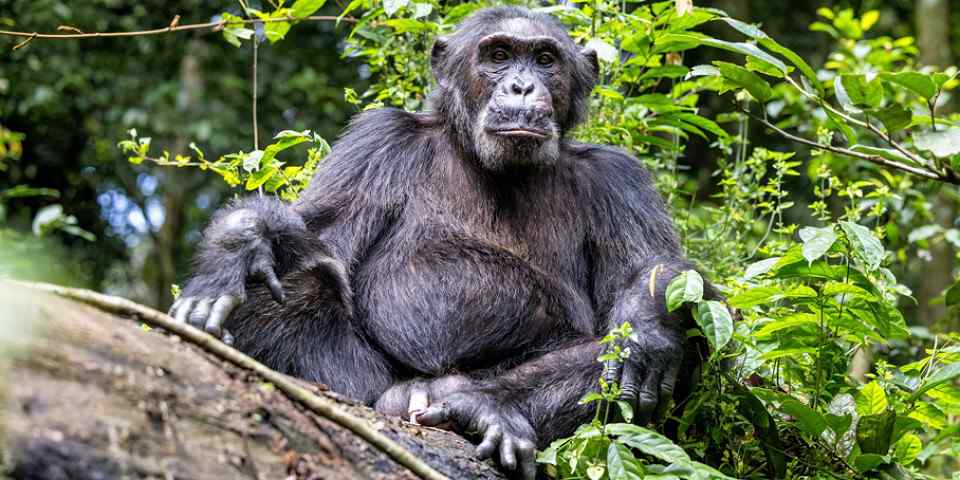Tour Length
Rates in USD $ – Change Currency
Per person, excl. international flightsOperator Rating
Other Tour Features
Filter by Operator
Filter by Accommodation
Chimp Trekking Tours
A chimpanzee trekking safari offers a special opportunity to see our closest relatives at close range. Although it doesn’t get the same attention as gorilla trekking, the experience can be quite similar. The intelligence and social structure of chimps make them fascinating subjects for observation, and no two visits are the same. Chimpanzees live in communities ranging from 20 to 150 individuals. Like humans, they tend to have strong personalities. Their expressive faces make their identities easily recognized by us, even during a short visit. Lucky visitors will be able to hear their pant-hooting. This communal, loud calling session can be triggered by anything that excites them – including you.
-

14-Day Uganda Gorilla Chimpanzees and Wildlife Safari
$4,070 pp (USD)
Uganda: Private tour
Mid-range Lodge & Tented CampYou Visit: Entebbe (Start), Sipi Falls (Highlight), Kidepo Valley NP, Murchison Falls NP, Ziwa Rhino Ranch, Kibale NP (Chimps), Queen Elizabeth NP, Bwindi Impenetrable NP (Gorillas), Lake Bunyonyi, Lake Mburo NP, Entebbe (End)

Dav Safaris
4.9/5 – 114 Reviews
-
Top Rated Operator

12-Day Best of Uganda Wildlife Tour
$7,899 to $8,299 pp (USD)
Uganda: Private tourLuxuryLodge & Guest House
You Visit: Entebbe (Start), Murchison Falls NP, Kibale NP (Chimps), Queen Elizabeth NP, Bwindi Impenetrable NP (Gorillas), Batwa Experience (Highlight), Lake Mburo NP, Entebbe (End)

Wayfairer Travel
4.8/5 – 185 Reviews
-

3-Day Chimpanzee Trekking & Canopy Walk in Nyungwe Park
$1,253 pp (USD)
Rwanda: Private tourBudgetGuest House
You Visit: Kigali (Start), Nyungwe NP (Chimps), Kigali (End)

Hermosa Life Tours and Travel
5.0/5 – 169 Reviews
-

8-Day Uganda Classic Adventure
$8,932 pp (USD)
Uganda: Private tourLuxuryLodge & Hotel
You Visit: Entebbe (Start), Entebbe Airport (Entebbe), Murchison Falls NP, Kibale NP (Chimps), Queen Elizabeth NP, Ishasha Sector (Queen Elizabeth NP), Bwindi Impenetrable NP (Gorillas), Entebbe (End)

Tubale Safaris
4.9/5 – 68 Reviews
-
![14-Day -Day Uganda Luxury Safari and Gorila Adventure]()
14-Day -Day Uganda Luxury Safari and Gorila Adventure
$6,853 pp (USD)
Uganda: Private tourLuxuryLodge & Hotel
You Visit: Entebbe (Start), Kampala (City), Murchison Falls NP, Kibale NP (Chimps), Queen Elizabeth NP, Bwindi Impenetrable NP (Gorillas), Lake Bunyonyi, Lake Mburo NP, Jinja (Town), Entebbe (End)

Likana Safaris Uganda
5.0/5 – 30 Reviews
-
![5-Day Rwanda Chimps , Colobus Monkeys & Canopy Walk Tour]()
5-Day Rwanda Chimps , Colobus Monkeys & Canopy Walk Tour
$2,218 pp (USD)
Rwanda: Private tour
Mid-range HotelYou Visit: Kigali (Start), Nyungwe NP (Chimps), Kigali (End)

Lion Safaris
5.0/5 – 39 Reviews
-
![10-Day Wildlife, Big 5, Chimpanzee, and Gorilla Safari]()
10-Day Wildlife, Big 5, Chimpanzee, and Gorilla Safari
$3,410 to $3,630 pp (USD)
Uganda: Private tour
Mid-range Lodge & ResortYou Visit: Entebbe (Start), Murchison Falls NP, Kibale NP (Chimps), Queen Elizabeth NP, Bwindi Impenetrable NP (Gorillas), Lake Bunyonyi, Lake Mburo NP, Entebbe (End)

Lulu Safaris Uganda
4.9/5 – 151 Reviews
-
![3-Day Queen Elizabeth Wildlife Chimpanzee Combo]()
3-Day Queen Elizabeth Wildlife Chimpanzee Combo
$688 pp (USD)
Uganda: Shared tour (max 7 people per vehicle)BudgetLodge
You Visit: Entebbe (Start), Queen Elizabeth NP, Entebbe Airport (End)

Big Apes Africa
5.0/5 – 116 Reviews
-
![3-Day Kibale Chimpanzee Trekking Experience]()
3-Day Kibale Chimpanzee Trekking Experience
$792 pp (USD)
Uganda: Private tourBudgetLodge
You Visit: Entebbe (Start), Kibale NP (Chimps), Entebbe (End)

Moroka Expeditions
5.0/5 – 43 Reviews
-
![5-Day Lion & Leopard Tracking + Gorilla & Chimp Tracking]()
5-Day Lion & Leopard Tracking + Gorilla & Chimp Tracking
$3,333 pp (USD)
Uganda: Private tour
Mid-range Lodge & HotelYou Visit: Entebbe (Start), Kibale NP (Chimps), Queen Elizabeth NP, Bwindi Impenetrable NP (Gorillas), Kigali (End)

Lush Africa Safaris
4.8/5 – 47 Reviews
-
![7-Day Uganda Whisper of Nature and Chimpanzee Trekking]()
7-Day Uganda Whisper of Nature and Chimpanzee Trekking
$1,619 pp (USD)
Uganda: Private tourBudgetLodge & Guest House
You Visit: Kampala (Start), Kibale NP (Chimps), Queen Elizabeth NP, Lake Bunyonyi, Lake Mburo NP, Kampala (End)

Mugenyi Eco Tours
5.0/5 – 13 Reviews
-

5-Day Gorillas, Chimps, Wildlife, Unique Overland Style
$3,113 to $3,269 pp (USD)
Uganda: Private tourBudgetCamping & Banda
You Visit: Entebbe (Start), Lake Mburo NP, Bwindi Impenetrable NP (Gorillas), Ishasha Sector (Queen Elizabeth NP), Queen Elizabeth NP, Kyambura Gorge (Chimps), Entebbe (End)

Meanda Uganda
5.0/5 – 21 Reviews
-
![5-Day Queen Elizabeth NP and Bwindi National Park Safari]()
5-Day Queen Elizabeth NP and Bwindi National Park Safari
$2,585 pp (USD)
Uganda: Shared tour (max 6 people per vehicle)BudgetLodge & Hotel
You Visit: Kampala (Start), Queen Elizabeth NP, Bwindi Impenetrable NP (Gorillas), Kampala (End)

Bugoli Adventures
5.0/5 – 16 Reviews
-
![5-Day Mahale Chimpanzee Trekking and Romantic Getaways]()
5-Day Mahale Chimpanzee Trekking and Romantic Getaways
$1,953 pp (USD)
Tanzania: Private tourBudgetGuest House & Hotel
You Visit: Dar Es Salaam (Start), Mahale Mountains NP, Kigoma (Town), Dar Es Salaam (End)

Go Giraffe Safaris
5.0/5 – 24 Reviews
-
![3-Day Tour to Queen Elizabeth National Park]()
3-Day Tour to Queen Elizabeth National Park
$1,045 pp (USD)
Uganda: Shared tour (max 10 people per vehicle)BudgetLodge
You Visit: Entebbe (Start), Queen Elizabeth NP, Entebbe (End)

East African Jungle Safaris
5.0/5 – 149 Reviews
-
![3-Day Queen Elizabeth National Park and Chimp Trek]()
3-Day Queen Elizabeth National Park and Chimp Trek
$795 pp (USD)
Uganda: Private tourBudgetLodge
You Visit: Entebbe (Start), Queen Elizabeth NP, Entebbe Airport (End)

Primate Ape Safaris Africa
4.7/5 – 15 Reviews
-
![5-Day Gorillas and Chimps Tracking Experience]()
5-Day Gorillas and Chimps Tracking Experience
$2,200 pp (USD)
Uganda: Private tour
Mid-range Lodge & Tented CampYou Visit: Entebbe (Start), Kibale NP (Chimps), Bwindi Impenetrable NP (Gorillas), Entebbe (End)

NGONI Safaris Uganda
4.9/5 – 182 Reviews
-
![4-Day Gorilla & Chimpanzee Trek Safari (Midrange Tour)]()
4-Day Gorilla & Chimpanzee Trek Safari (Midrange Tour)
$2,049 pp (USD)
Uganda: Shared tour (max 3 people per group)
Mid-range Lodge & Guest HouseYou Visit: Entebbe (Start), Kibale NP (Chimps), Bwindi Impenetrable NP (Gorillas), Entebbe (City), Kampala (End)

Epic Uganda Vacation
5.0/5 – 46 Reviews
-
![12-Day Uganda Big Five, Chimps, Gorillas, and Nature Tour]()
12-Day Uganda Big Five, Chimps, Gorillas, and Nature Tour
$4,290 pp (USD)
Uganda: Private tour
Mid-range Lodge & Tented CampYou Visit: Entebbe (Start), Entebbe Airport (Entebbe), Murchison Falls NP, Kibale NP (Chimps), Queen Elizabeth NP, Bwindi Impenetrable NP (Gorillas), Lake Bunyonyi, Lake Mburo NP, Entebbe (End)

Jackal Adventures Uganda
4.9/5 – 7 Reviews
-
![10-Day A Journey Through the Pearl of Africa]()
10-Day A Journey Through the Pearl of Africa
$4,271 pp (USD)
Uganda: Private tour
Mid-range Camping & LodgeYou Visit: Entebbe (Start), Entebbe Airport (Entebbe), Murchison Falls NP, Kibale NP (Chimps), Queen Elizabeth NP, Bwindi Impenetrable NP (Gorillas), Entebbe (End)

Giant Holiday Safaris
5.0/5 – 6 Reviews
6 Questions About Chimp Trekking Tours

Answered by
Ariadne van Zandbergen
Ariadne is a renowned African wildlife photographer whose work is featured in many well-known guidebooks and magazines. She recommends chimp trekking at least twice during a safari. This is because experiences vary, and it will increase your chances of having a very special encounter with chimpanzees.› More about Ariadne
6 Questions About Chimp Trekking Tours
 Ariadne van Zandbergen
Ariadne van Zandbergen
1. Why should I choose a chimp trekking safari?
“Chimpanzee trekking is totally different from the usual safari experience. As chimpanzees live in rainforest, the only access is by foot. Chimp trekking is active and usually requires hiking for several hours to see chimps up close. Watching these great apes up close on foot is an amazing experience, almost on a par with gorilla trekking. Most African safaris are centered on car-based wildlife viewing, and activities such as chimp trekking offer a nice break from time sitting in vehicles. Chimp trekking is mostly done as part of a longer tour that includes other activities, such as wildlife viewing in savannah reserves and gorilla trekking.”
1Which countries offer chimpanzee trekking tours?
“Chimp trekking can be done in several African countries. Chimpanzees occur naturally in West and Central Africa, and their range includes some East African countries such as Tanzania, Uganda and Rwanda. The East African countries are the most popular countries for chimpanzee safaris as they are more developed for tourism than West Africa. There are several parks in Uganda that offer chimp trekking and the activity is included on most Ugandan safari itineraries. One of the most reliable places to see chimpanzees is in Uganda’s Kibale National Park. This is arguably the most popular chimp trekking destination in Africa, which means it is relatively busy and sightings can get a bit crowded. Because of this, people seeking a more exclusive experience in Uganda often choose to track chimps elsewhere. Good options include Budongo Forest near Murchison Falls National Park, Kyambura Gorge in Queen Elizabeth National Park and a community-run project in Kalinzu Forest Reserve. In Tanzania, chimp trekking is available only in Mahale Mountains and Gombe National Parks (both on the shore of Lake Tanganyika) as well as on Rubondo Island National Park in Lake Victoria. Gombe and Mahale host chimp communities that were first habituated to human presence in the 1960s. Gombe is also famous for its association with Jane Goodall, who did her research there. Although chimp trekking in Gombe and Mahale is of the highest quality, the remote location of these parks makes them difficult to incorporate the activity in a standard Tanzania safari. Chimp trekking in Rubondo is a relatively new development and less reliable than elsewhere in Tanzania or Uganda. Chimpanzee trekking is also available in Rwanda’s Nyungwe National Park. This is still an emerging destination, so less well-known at this stage, and sightings are a bit more hit-and-miss.”
2What fitness level is required?
“Chimpanzee trekking requires a reasonable amount of fitness. It depends on where you will be trekking, and to some extent it just depends on the day. Even in a particular park, every day can be different. You might find the chimps after 10 minutes or after two hours. And then they might be stationary, or feeding in trees, or they might be on the move. The latter can result in a very challenging trek as you try to keep up with them moving through the undergrowth at high speed. The terrain in some of the parks is hillier than in others. One of the easiest places to see chimpanzees is in Kibale NP in Uganda. Other rewarding places to see chimpanzees are Mahale Mountains and Gombe NPs in Tanzania, where the terrain is very hilly, and a fair amount of fitness is required. If you prefer to stick to flattish terrain, Budongo Forest in Uganda is probably your best bet.”
3How close can I get to the chimps?
“Chimpanzees are our closest living relatives and they share 98.8% of our DNA. That means they can easily pick up human diseases. For this reason, and also for safety reasons, it is vital to keep a reasonable distance when watching chimpanzees. You will track chimpanzees in a small group of up to 10 people. Your guide will give you very clear instructions on where to stay when you get close to the chimps. Having said that, the chimps themselves are very habituated and they don’t abide by rules. On top of that, the thick forest growth might make backing off difficult at times. So, it is very possible a chimpanzee may come within a meter of you.”
4How much will this safari cost?
“The cost of chimp trekking packages depends on the country and the park. In Tanzania, the chimpanzee trekking fee is included in the park entrance for Mahale Mountains and Gombe, which is respectively US$80 and US$100 per person per day. This is very affordable, but due to the exclusivity and remoteness of these parks, the overall price of a safari here is high. A chimp permit in Kibale National Park in Uganda costs US$200. In Queen Elizabeth’s Kyambura Gorge, the fee is US$50 on top of the general entry fee of US$40. The fee for chimp trekking in Kalinzu or Budongo Forest is now US$130. Chimp trekking in Rwanda’s Nyungwe National Park costs US$90.”
5How does chimp trekking compare to gorilla trekking?
“Gorilla and chimp trekking are very similar experiences. You set out with a maximum number of visitors: eight for gorilla trekking and up to 10 in some places for chimp trekking. For gorillas, trackers go ahead, and your guide will be in touch with them by radio to guide you directly to the gorillas. This is not always the case with chimp trekking. Your guide might have to do the tracking themselves, which can make the hike more challenging and the success rate lower. Once you have reached the gorillas or chimps, you get an hour to spend time with them before heading back. Gorillas don’t cover as much ground as chimps, and you will most likely stay with gorillas in a small area. Chimps, on the other hand, can be hard to follow when they are on the move. All gorilla groups for tourist visits are very habituated, so time spent with them tends to be of a very high quality. This isn’t always the case with chimpanzees. Chimps are very habituated in places such as Mahale, Gombe and Kibale, but they might be less so in other places, and tend to move off slowly. In some cases, the males are more relaxed than the females and babies. I think both experiences are highly rewarding, but the chimpanzee trekking experience is more variable depending on several factors. Also, being close to an ape the size of a gorilla has a thrill factor that might not be quite the same with chimpanzees.”
6































